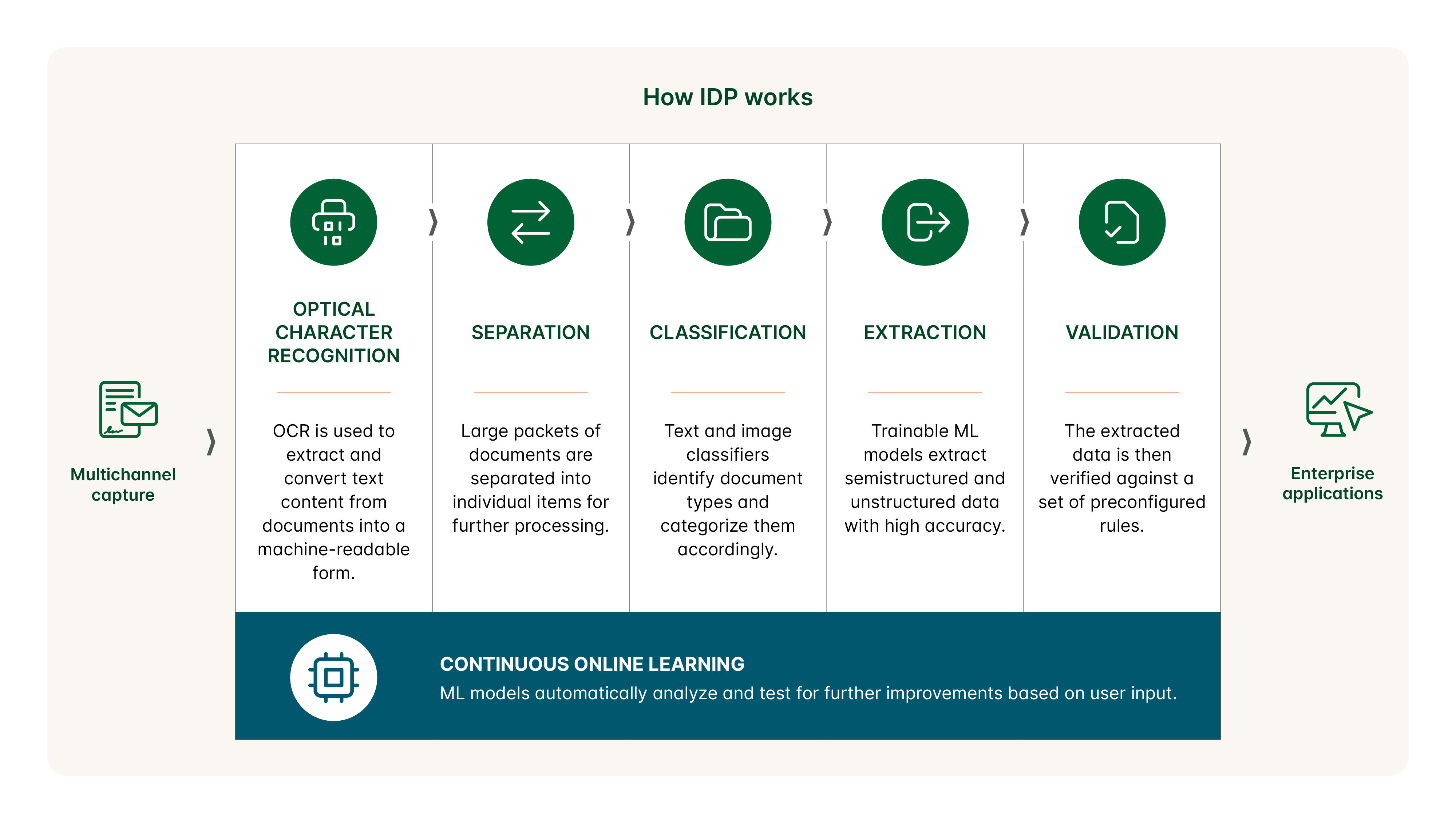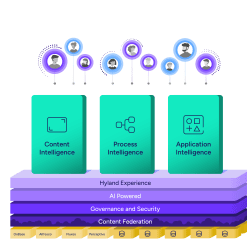Future-forward organizations understand that data, when leveraged right, can be a foundation for success. However, for many enterprises, the torrential volume of data generated from day-to-day operations is constantly outpacing their capacity to effectively manage it.
Deciphering what’s noise and what’s truly valuable from this sea of data can be a challenge — and here is where intelligent document processing (IDP) emerges as a lifeline. By shifting from manual document processing to an automated, AI-driven approach, IDP enables organizations to tap into their data to unlock enterprise-wide transformation.
What is intelligent document processing (IDP)?
IDP is a subset of intelligent automation that uses cutting-edge artificial intelligence (AI) to process information within unstructured and semistructured data. It extracts, reads, recognizes and understands text content before converting it into a structured, accessible format.
Think of IDP as a smart assistant for your business documents — it enables straight-through processing for various dynamic file formats like invoices, contracts, emails and images at speed and scale, all without additional human input. By eliminating the need for cumbersome manual work, it supercharges your operational efficiency and workforce productivity.
IDP solutions are developed to mimic human cognition. They operate on advanced, continuous learning engines that get smarter over time, automatically deploying improvements to their data capture and extraction algorithms for precise results.
> Read more: The future of intelligent enterprise is AI-powered IDP
How does IDP work?
IDP combines automation and optical character recognition (OCR) technologies with AI capabilities like natural language processing (NLP), machine learning (ML) and deep learning to capture and contextualize data for greater accuracy.
While many of these capabilities have existed for some time now (think "intelligent capture" solutions), advances in AI and low-code technology have enabled leading software providers to bring to market truly next-generation IDP platforms.
Here’s how an enterprise-grade IDP solution works:
Step 1: Document preprocessing
Documents are ingested into the processing platform and prepared for analysis. They are first scanned through OCR technology and processed using capture techniques like noise reduction and deskewing to enhance data readability and quality.
Step 2: Document separation
Large packets of multiple documents are split into individual documents for further processing.
Step 3: Document classification
The document is then classified based on its content, format and structure. NLP algorithms, which look at data in a human-like way, are then deployed to interpret text contextually to recognize business-critical information.
Step 4: Data extraction
The software then identifies and extracts the relevant data, such as names, addresses and numbers. ML continually refines the IDP software’s performance over time, improving the accuracy and efficiency of the extraction process.
Step 5: Data validation
Any errors in the extracted data are flagged for review. Human-in-the-loop validation resolves discrepancies while finetuning the model’s prediction algorithms to accelerate its learning process. The final output is then integrated into databases or other downstream workflows for further analysis.

Are IDP and RPA the same?
IDP is often used interchangeably with robotic process automation (RPA), which is incorrect. While the primary function of both is to automate data-centric processes, there are distinct differences between these two complementary technologies.
RPA is a programmatic solution deployed to automate repetitive, predictable tasks whereas IDP has native intelligence to handle more complex, data-centric work. Together, IDP augments RPA capabilities to form a truly comprehensive end-to-end automation solution that is capable of producing highly accurate and efficient outputs.
> Read more: How RPA and AI drive end-to-end intelligent process automation
Why is IDP important?
Beyond just digitizing documents, IDP is a powerful catalyst for modernization. As important business information grows in volume and complexity, manual document processing is no longer a viable option; it leads to costly errors and workflow bottlenecks that can disrupt operations.
Implementing IDP circumvents these challenges, enabling quick, accurate and cost-effective document processing.
Take invoices for example — IDP solves the inefficiencies of handling paper invoices manually as critical information like purchase order numbers and supplier names are extracted and converted into a digital format, speeding up the data entry process.
This automated workflow seamlessly integrates into relevant accounting systems, resulting in an error-free and cost-effective invoice processing system with improved document management capabilities.
According to Bain and Company, executives found that team members can take on higher value work with automation in their workflow. This same report suggests a 45% increase in staff flexibility after implementation, along with a few other benefits to your bottom line.
Up to 20%
in cost savings
34%
faster processes
32%
improvement in service quality
Furthermore, IDP also acts as a competitive differentiator, turning raw data into critical business intelligence that spurs greater innovation and growth.
80% of respondents found that process intelligence drives better business outcomes by identifying high-value processes.
— Deloitte, Automation with Intelligence, 2022
With these strengths in mind, it’s easy to understand why many organizations are beginning to prioritize IDP in their process optimization efforts — and why you should too.
What are the benefits of IDP?
Modern IDP solutions are a game-changer (even when compared to legacy IDP offerings) for any enterprise with document-heavy processes. It brings tangible business benefits like:
Better efficiency and accuracy
IDP minimizes the human errors commonly associated with manual processing by reliably capturing data at high accuracy. Automating document-centric tasks also streamlines workflows and reduces business cycle times, enhancing enterprise-wide efficiency.
Time and cost savings
Optimizing routine back-office processes by deploying AI-based extraction techniques can save businesses 30-40% of the hours and 20% of the operational costs typically spent on document processing.
Faster, powerful decision-making
Harness valuable data-driven insights to support rapid, strategic business decisions that capitalize on emerging trends or gain a competitive advantage.
Improved employee productivity
As IDP relieves your employees from manual input work, they can now focus on higher-value strategic initiatives instead.
Enhanced customer service
IDP empowers your team to deliver exceptional customer experiences by drastically reducing response times to queries. The extracted data also provides a personalized approach to addressing individual customer needs.
Compliance and risk management
IDP’s automated document classification capabilities strengthen compliance and data governance efforts by ensuring that records are managed and retained according to the appropriate regulatory policies.
Data security
Safeguard confidential data by reducing human touch and with robust built-in security measures like data encryption and access controls that adhere to global data privacy and security standards.
A configurable, scalable platform
IDP solutions can vary in capabilities, but ideal platforms are versatile (rather than fixed, hard-wired, pro-code solutions) and can be customized to meet a wide range of industry applications. Its scalable architecture also accommodates increasing volumes of documents without compromising performance.
Seamless integration
Designed to seamlessly integrate with existing enterprise applications such as ERP and CRM platforms, IDP bridges content silos to support effective cross-functional collaboration.
Read more: Your guide to intelligent document processing (IDP)
5 common use cases for IDP
Due to its agile and versatile nature, IDP offers an industry-agnostic solution to data processing. Check out some of its common applications below:
- Insurance: Insurance firms deploy IDP to automate the claims cycle, expedite turnaround times and optimize the underwriting process. The software’s continuously learning AI also analyzes data patterns to detect fraudulent activities.
- Healthcare: IDP reduces the administrative burden on clinicians by streamlining the processing of patient records, medical imaging and lab results. IDP also draws valuable insights from these troves of data to enable a unified view of the patient for improved outcomes.
> Learn more | The power of intelligent document processing (IDP) in healthcare
- Financial services: In highly regulated industries like commercial banking, IDP accurately extracts and validates customer data for loan applications, account openings and KYC (Know Your Customer) verifications.
- Accounts payable: IDP’s AI-based software speeds up invoice approvals, ensuring timely payments that allow your team to capture early payment discounts. Its predictive analytic capabilities also offer a big-picture perspective for optimized cash flow management.
- Human resources: IDP’s ability to recognize complex text and syntax makes it ideal for handling HR’s content-centric responsibilities, from recruiting to performance management. It simplifies these processes by ingesting large amounts of documents and automatically extracting and storing them for future applications.
> Read more: 20 intelligent document processing (IDP) use cases
Choosing the right IDP software for your organization
With various IDP offerings available on the market, it can be difficult to select one for your business. It’s important to consider how IDP can address your specific organizational needs and whether it has the right functionalities to support them.
Here are a few characteristics to look for when evaluating options:
How accurate is it?
Most IDP solutions have an accuracy rate ranging from 80% to as high as 99%. Ask the vendor how accurate the solution’s AI-powered engine is when extracting, classifying and verifying complex document types, including structured and unstructured formats.
Does it deliver consistently?
Assess how reliable the solution is at handling an influx of documents while ensuring quality output.
Is it scalable to your needs?
Look for a configurable option that allows even nontechnical users to extend the platform’s capabilities with low-code or no-code tools to accommodate your expanding business needs.
Is it user-friendly?
The solution should have an intuitive, web-based user interface that’s easy to use and integrates seamlessly with existing business applications.
What are its data governance policies?
Information governance is a high priority for many enterprises. Ensure the solution has robust data logging and structured document retention policies in place for compliance and auditing purposes.
How effective is its training model?
IDP solutions operate on a built-in intelligence model that can learn, improve and train itself over time. Be sure to understand the extent of its AI-based capabilities and limitations, and how effectively it can incorporate human input.
Do you have access to technical support?
The vendor should also provide access to comprehensive technical training and expert support as needed.
IDP is critical for modernizing your workplace
The integration of IDP into business operations is not just a step toward automation; it’s a leap toward a more data-intelligent future. Hyland IDP features integrated process automation, advanced AI-driven data extraction and a highly scalable, low-code architecture to accelerate platform deployment and expansion.
In today’s data-driven landscape, IDP revolutionizes how data is managed with unparalleled speed, efficiency and accuracy. Investing in Hyland IDP is an investment in the future of your enterprise, generating valuable business outcomes and unlocking greater innovations such as establishing new use cases for AI-enabled automation.
With its always-learning AI model, Hyland IDP will only become more powerful, precise and faster with time, ultimately enhancing your return on investment. If your goal is to transform your enterprise into an intelligent digital organization, it may be worthwhile to consider Hyland IDP as a way to bring your most critical data to life.
You may also like:

Article
What can you do with Hyland Intelligent Document Processing (IDP)?
Hyland’s AI-powered intelligent document processing solution brings instant value and efficiency to teams that work with document capture, classification, extraction and validation.

Article
A beginner’s guide to intelligent document processing (IDP)
Make the most out of your data and turn document processing from a cost center into a value driver for your organization.

Article
20 intelligent document processing (IDP) use cases
Explore how IDP is helping businesses across various industries transform their operations for enhanced efficiency.











